Planets Move in Morning While an Evening Moon Waxes, and Then Gets Eclipsed by Earth’s Umbra!
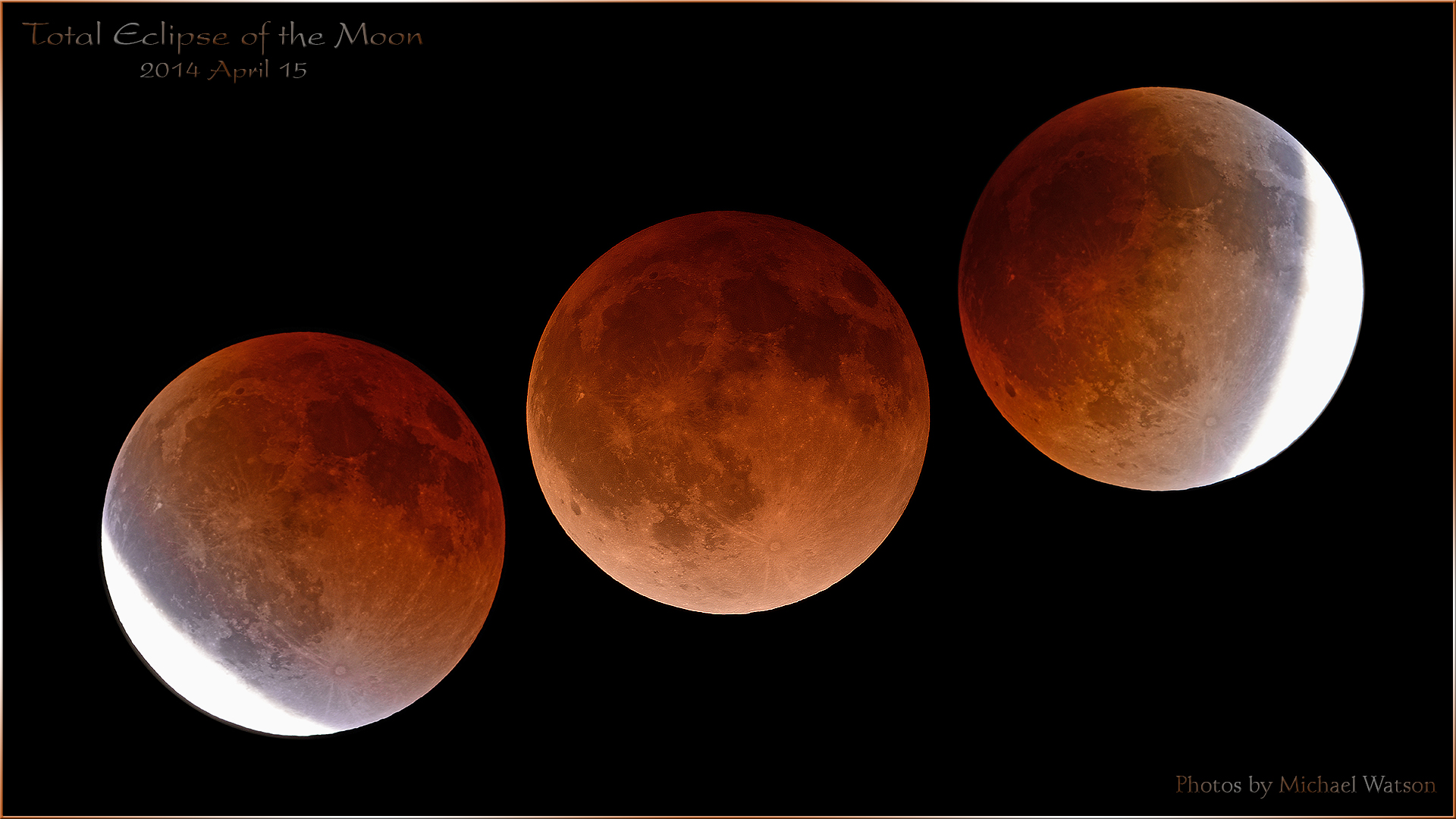
This beautiful composite image, taken by Michael Watson of Toronto during the Total Lunar Eclipse of April 15, 2014, closely resembles what observers in most of the Americas will see starting on Sunday night, May 15, 2022. Michael has arranged the images to show the round shape of Earth’s shadow, as expressed during the partial phases, and the darkening of the moon’s disk towards the centre of the umbra during totality. More of Michael’s astro-images can be viewed at his Flickr page, https://www.flickr.com/photos/97587627@N06/
It’s a Moony Week, Stargazers!
Here are your Astronomy Skylights for the week of May 8th, 2022 by Chris Vaughan. Feel free to pass this along to your friends and send me your comments, questions, and suggested topics. You can also follow me on Twitter as @astrogeoguy! Unless otherwise noted, all times are expressed in Eastern Time. To subscribe to these emails please click this MailChimp link.
If you’d like me to bring my Digital Starlab portable inflatable planetarium to your school or other daytime or evening event, or deliver a session online, contact me through AstroGeo.ca, and we’ll tour the Universe, or the Earth’s interior, together! My terrific new book with John A. Read entitled 110 Things to See With a Telescope is a guide to viewing the deep sky objects in the Messier List – for both beginners and seasoned astronomers. DM me to order a signed copy!
The moon will dominate night skies worldwide this week as it waxes from First Quarter to a Full Moon Total Lunar Eclipse next Sunday night. Meanwhile, Mercury will end its best appearance of 2022, binoculars Comet C/2021 O3 PanSTARRS might climb through the Giraffe in evening, and the eastern morning sky will host five planets! Read on for your Skylights!
Eta-Aquariids Meteor Shower
The annual Eta-Aquariids Meteor Shower, produced when Earth travels through a cloud of particles of material left behind by repeated passages of Halley’s Comet, peaked last Friday morning. You can keep an eye out for a few stragglers until mid-week. Genuine Eta-Aquariids meteors will appear to be travelling away from a radiant point in the sky near the constellation of Aquarius (the Water-Bearer). That spot rises above the southeastern horizon, above Mars and Saturn, around 3 am.
The Moon
The moon will dominate the night sky worldwide this week as it waxes fuller. Today (Sunday), the half-illuminated moon will rise around noon in your local time zone and lead the Sickle-stars of Leo (the Lion) across the sky until beyond midnight. The moon will officially complete the first quarter of its orbit around Earth at 8:21 pm EDT on Sunday, May 8 (or 00:21 GMT on Monday, May 9). At that phase, the 90 degree angle formed by the Earth, sun, and moon will cause us to see our natural satellite half-illuminated – on its eastern, sun-facing side.
Evenings until late this week will be ideal for viewing the spectacular lunar terrain while it is enhanced by slanted rays of sunlight. Sites along the curved terminator, the pole-to-pole boundary that separates the lit and dark hemispheres, are experiencing sunrise on the moon. The topography to the right (lunar east) of that boundary will consist of brightly lit peaks and crater rims with pitch dark shadows to their west. The subtle wrinkles within the dark maria will be enhanced, too. The terminator will migrate steadily westward across the moon’s face, so dust off your binoculars and telescopes and view it every night! It’s perfectly safe to view the moon through optics in daytime, too – just ensure that the kids don’t turn them towards the sun. The moon looks terrific during evening twilight.
Our natural nightlight will pass above the bright star Regulus, the heart of the lion, on Monday, and the hindquarters of Leo on Tuesday. By then, the waxing gibbous (i.e., more than 50%-illuminated) moon will be rising in mid-afternoon and lingering well into the wee hours. From Wednesday to Friday, the moon will caress the flanks of Virgo (the Maiden). It’s nearly full orb will gleam above her bright, white hip-star Spica on Friday.
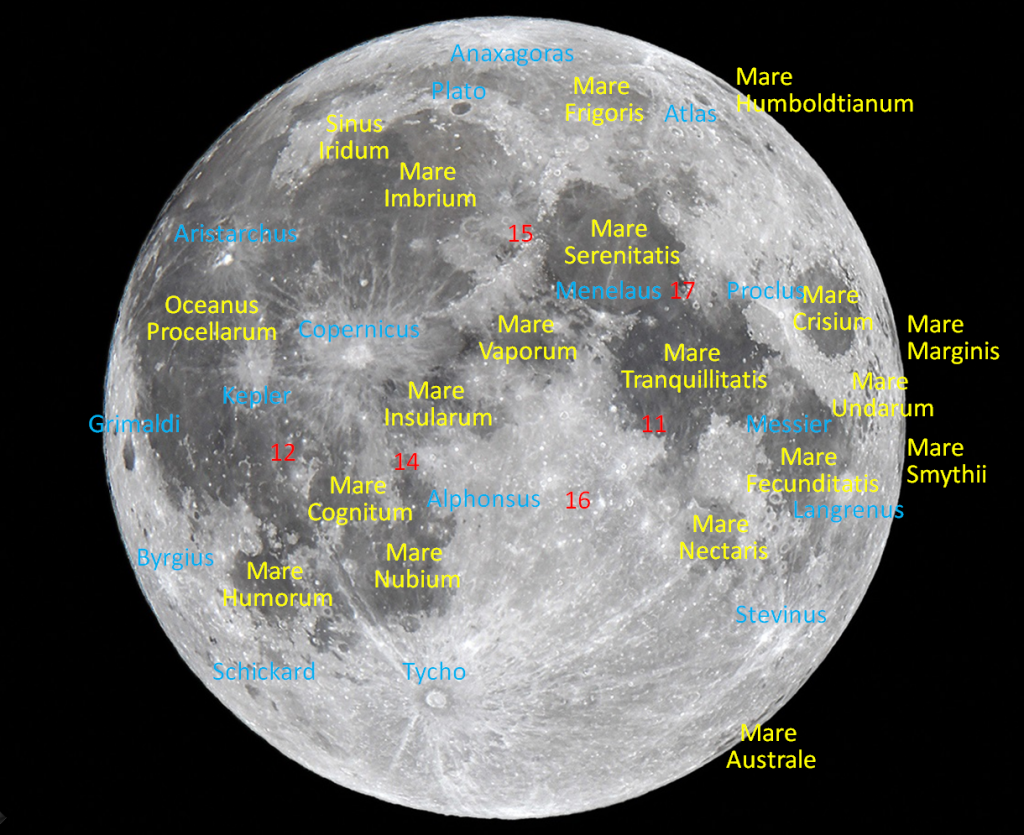
The very bright, full-looking moon will spend the weekend among the not-very-bright stars of Libra (the Scales). On Saturday night, magnified views of the moon will reveal a thin strip of darkness, and some shadow-enhanced craters, along the moon’s left-hand edge (or the lunar western limb). Look for an isolated small, dark patch located near the non-illuminated zone. That’s a basalt-filled basin named Grimaldi. A less-distinct crater beside Grimaldi will sit right against the moon’s western edge. That’s Riccioli. Grimaldi and Riccioli were fellow Jesuit priests. Giovanni Battista Riccioli’s moon map, which he published in 1651, gave us the names we use today. Watch for a dark stain in the top portion of Riccioli – an ancient volcanic ash deposit.
A Total Lunar Eclipse!
Full moons occur while the moon is positioned opposite the sun in the sky. That occurs every 29.53 days, otherwise known as the moon’s synodic period. New moons occur when the moon crosses the line between Earth and sun. Most of the time, the 5 degree tilt of the moon’s orbit causes it to pass high (celestial north) or low (celestial south) of the precise anti-solar point and the Earth-sun point, which both sit on the ecliptic. But about every 18 months, the moon will be new or full while it’s near the point where its orbit crosses the ecliptic, causing a solar or lunar eclipse to occur. In fact, we usually get both, separated by two weeks.
A partial solar eclipse occurred on April 30. The moon will reach its full phase at 12:14 am EDT (or 04:14 Greenwich Mean Time) on Monday, May 16 – and that one will give much of the world a spectacular total lunar eclipse that will commence on Sunday evening in the Americas!
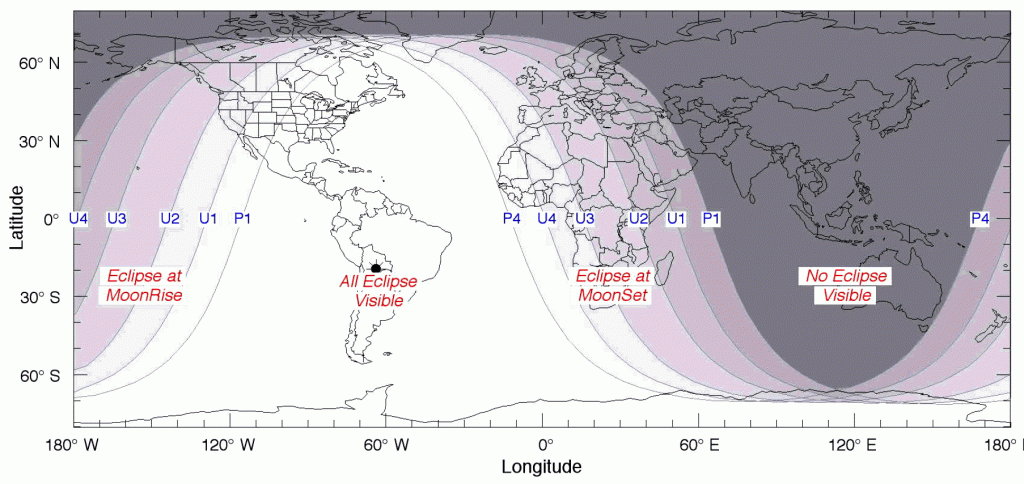
The total lunar eclipse will be observable in eastern North America, Central America, and South America. For the rest of North America, Hawaii, and the eastern Pacific Ocean, the eclipse will be in progress as the moon rises at sunset. Western Europe and Africa will see only the later stages before the moon sets at sunrise.
Let’s look at what will happen. The sun shining on the spherical Earth leaves a round shadow cast into space opposite to the sun. That shadow, called the umbra, is always there in the night sky. It’s what makes satellites suddenly disappear (as they dip into it) or appear (as they exit from it) at night. At the moon’s distance of 360,000 km, the umbra covers a disk of sky about as wide as your thumb. For satellites orbiting a few hundred km above the Earth’s surface, that shadow is much, much wider.
Objects entirely within the umbra are not receiving any direct rays of sunlight. Surrounding the umbra is a ring of partial shadow, called the penumbra. For objects in that zone, part of the sun remains unblocked by Earth, so they are receiving sunlight. Surprisingly, almost any amount of exposed sun will brightly illuminate an object – so objects in the penumbra are barely diminished in brightness. At the moon’s distance, the penumbra is almost twice as wide as the umbra.
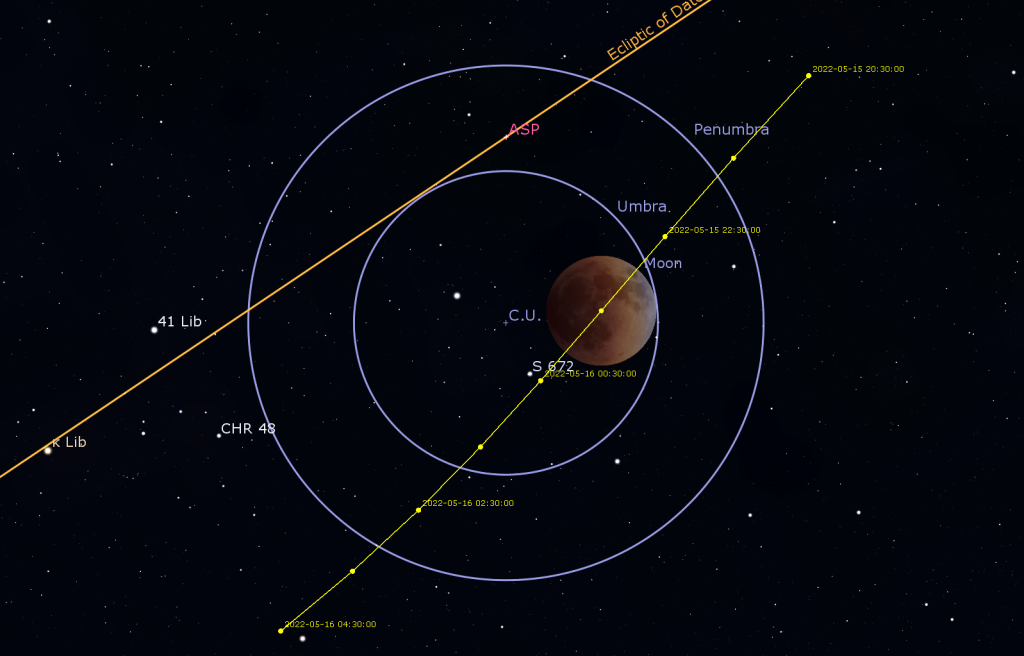
During a lunar eclipse, the moon’s steady eastward orbital motion – by about its own diameter each hour – carry it through Earth’s shadow regions. While the moon is partially within the umbra, in the early or late stages of a total eclipse, or during a partial lunar eclipse, we see the characteristic “bite out of the moon”. While the moon is crossing fully within the umbra, it turns a deep reddish-orange colour. That’s because rays of sunlight are refracted through the thin layer of air surrounding the Earth, and bent into the umbra zone. Sunlight skimming the Earth’s horizon, such as at sunset and sunrise, is tinted orange and red because those wavelengths pass straight through 10-20 times as much air while blues and greens fail to make the trip. Someday, an astronaut standing on the moon during a total lunar eclipse will see a reddish ring of sunset-coloured light all around the Earth’s edge! The media have adopted the unfortunate and sensational term “Blood Moon” for a simple and benign lunar eclipse. Why scare folks, I ask?
The length of a total eclipse depends on whether the moon crosses the full diameter of the umbra, which takes more time, or takes the faster path closer to the edge. The moon will start dipping into the penumbra at 9:32 pm EDT (or 01:32 GMT), but you won’t really notice any effects.
First contact with the umbra, or “first bite”, will occur at 10:28 pm EDT (or 02:28 GMT). In the Eastern Time Zone the moon will then be in the lower part of the southeastern sky. You may need to find a spot clear of buildings or trees. For observers west of Manitoba, the moon won’t be above the horizon yet. Totality will begin at 11:29 pm EDT and 9:29 pm CDT (or 03:29 GMT). This will be a very deep and lengthy total lunar eclipse, with the moon’s northern edge skimming the centre of the umbra.
After officially becoming full at mid-eclipse, the moon will begin to exit the umbra at 12:54 am EDT and 9:54 pm PDT (or 04:54 GMT), for a totality duration of 85 minutes. While the moon is fully eclipsed, watch for the upper (northern) part of the moon to be darkest red, and for the surrounding stars of Libra and brighter deep sky objects in Scorpius to return to view.

Lunar eclipses are completely safe to observe unfiltered with your unaided eyes, binoculars, and telescopes. If it’s cloudy where you are, tune in to a live stream on YouTube. Fair warning though, lunar eclipses are slow affairs. So you may want to watch a stream in Fast-Forward! Good luck, and tag me if you take pictures!
The Planets
Observers located at mid-Northern latitudes might still be able to catch sight of the bright little dot of Mercury swimming above the west-northwestern horizon after sunset from tonight (Sunday) to Wednesday. But it’ll be lower and fainter each night. Taurus’ brightest star Aldebaran will be shining almost a fist’s diameter to Mercury’s left (or 9° to the celestial northwest). Aldebaran will be considerably brighter than the planet – but it will twinkle. Always ensure that the sun has completely set before aiming binoculars or a backyard telescope towards the western horizon.
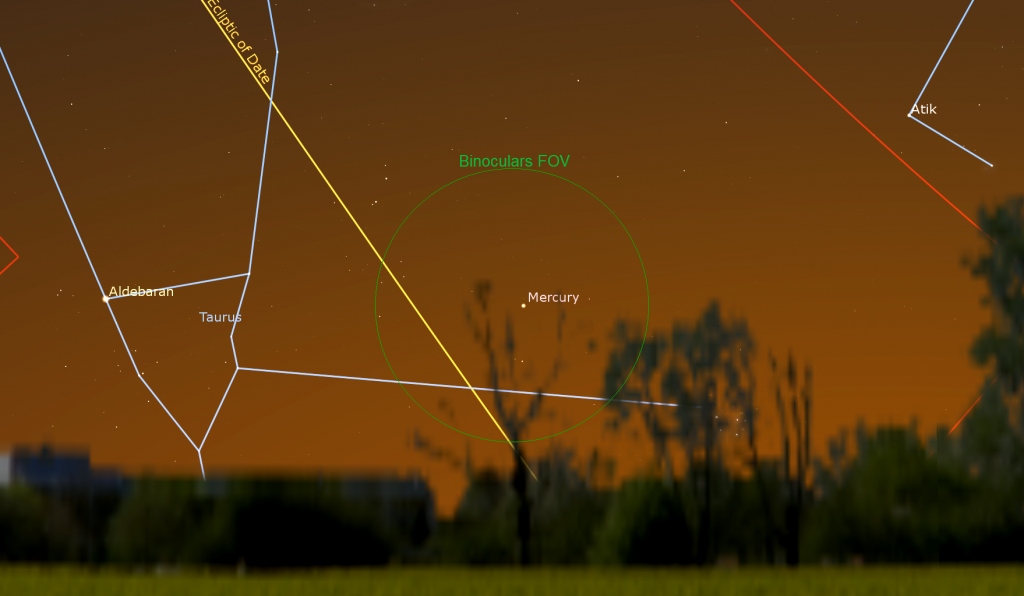
Early risers can spot the first of a chain of planets in the southeastern sky once yellowish Saturn rises at around 3 am local time. Saturn will remain visible to unaided eyes until about 5:30 am. During this week the main belt asteroid named (4) Vesta will be passing a finger’s width below and to the left (or 1° to the celestial southeast) of Saturn – but you’ll need good binoculars or a backyard telescope to see the magnitude 7.3 asteroid. Any size of telescope will show you Saturn’s full globe, its rings, and a few of its moons.
Mars will join the fun shortly before 4 am. Look for the reddish planet, shining with the same brightness as Saturn, about 2.3 fist diameters to the ringed planet’s lower left. It, too, will fade from view before sunrise. Much brighter, white Jupiter will rise about 20 minutes before dazzling Venus, which will complete the chain after 4:30 am local time. Those two planets will gleam until almost sunrise. Faint blue Neptune will be in the space between Mars and Jupiter. During the week, Venus will flee east from Jupiter, while Mars will approach Jupiter (and Neptune) from the west. The line of planets is showing you the plane of our solar system.
Venus will exhibit a football-shape in a backyard telescope and good binoculars. Mars will exhibit a tiny, 89%-illuminated disk. Jupiter will also get a little higher and farther from the sun with each passing day, allowing you to enjoy its dark equatorial bands, Great Red Spot (on Monday and Saturday morning), and four Galilean moons. Turn all optics away from the east before sunrise, please!

Wondering about Uranus? That planet reached conjunction with the sun on Cinco de Mayo! It will become visible in the pre-dawn sky after a meet up with Venus on June 11.
Comet Update
The comet named C/2021 O3 (PanSTARRS) should become a bit easier to see in the northwestern sky this week after dusk – although recent reports are that the comet disintegrated after its perihelion near the sun in late April. Assuming it survived, though …
it will travel between the very bright star Capella in Auriga (the Charioteer) and W-shaped Cassiopeia (the queen). Tonight (Sunday), the comet will be sitting a palm’s width to the upper left (or 6° to the celestial ESE) of the very bright star Mirfak in Perseus (the Hero). On each subsequent night this week, the comet will climb north through Camelopardalis (the Giraffe), carrying it farther from the sun and allowing the sky to darken around it, even though it will be fading in intensity from about magnitude 9.5.
From Thursday to Friday the comet will climb past the row of stars known as Kemble’s Cascade. Next Sunday night, it will be positioned a thumb’s width to the lower right (or 1.4 ° to the celestial WSW) of the giraffe’s brightest star, magnitude 4.25 Alpha Cam. Try to view the comet immediately after full darkness arrive, say 10:30 pm. In good binoculars and backyard telescopes, it’ll appear as a faint greenish, fuzzy patch.

Public Astro-Themed Events
Every Monday evening, York University’s Allan I. Carswell Observatory runs an online star party – broadcasting views from four telescopes/cameras, answering viewer questions, and taking requests! Details are here. They host in-person viewing on the first clear Wednesday night each month. Other Wednesdays they stream views online via the observatory YouTube channel. Details are here.
Weather permitting, on Tuesday, May 10 from 8:30 to 10 pm, astronomers from RASC – Mississauga will hold a free public star party at the Riverwood Conservancy, 4300 Riverwood Park Lane, Mississauga. Details are here.
My free, family-friendly Insider’s Guide to the Galaxy webcasts with Samantha Jewett of RASC National returns on Tuesday, May 10 at 3:30 pm EDT, when I’ll tell you how to take the free Stellarium program to the next level. Plus, we’ll continue with our Messier Objects observing certificate program and share some galaxy-viewing tips. You can find more details and the schedule of future sessions here.
RASC’s public sessions at the David Dunlap Observatory may not be running at the moment, but they are pleased to offer some virtual experiences instead in partnership with Richmond Hill. The modest fee supports RASC’s education and public outreach efforts at DDO.
On Friday night, May 13 from 8:30 to 10 pm EDT, the DDO Astronomy Speakers Night program will feature Dr. Nassim Bozorgnia, assistant professor in the Department of Physics and Astronomy at York University. She’ll speak on Hidden in Plain Sight: The Elusive Dark Matter. There will also be a virtual tour of the DDO and live-streamed views from the DDO’s 74-Inch telescope (weather permitting). Only one registration per household is required. Deadline to register for this program is Wednesday May 11, 2022 at 3 pm. More information is here and the registration link is here.
On Sunday afternoon, May 15 from 11 am to noon EDT, join me for Ask an Astronomer. During these family-friendly sessions, I’ll answer your questions about the universe and review what’s up nowadays. Only one registration per household is required. Deadline to register for this program is Wednesday, April 6, 2021 at 3 pm. Prior to the start of the program, registrants will be emailed the virtual program links. The registration link is here.
Don’t forget to take advantage of the astronomy-themed YouTube videos posted by RASC Toronto Centre and RASC Canada.
Keep looking up, and enjoy the sky when you do. I love questions and requests. Send me some!